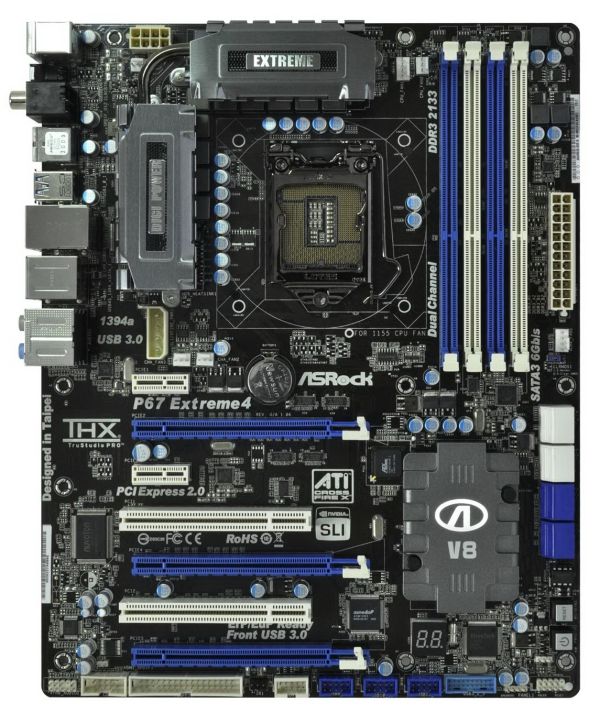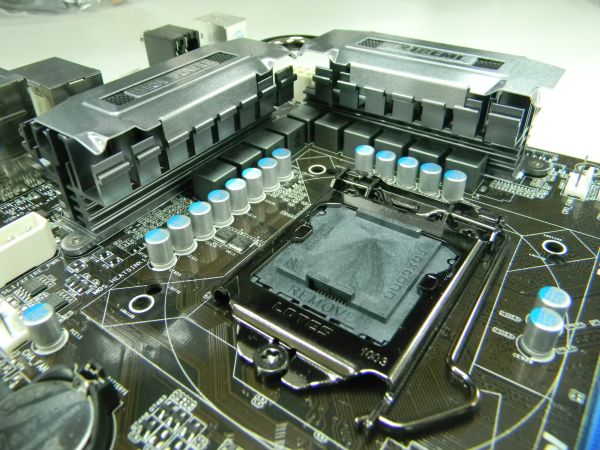Welcome to Sandy Bridge, with the ASRock P67 Extreme4
by Ian Cutress on January 3, 2011 7:00 AM EST- Posted in
- Motherboards
- ASRock
Demand for Sandy Bridge paraphernalia will be high—for almost a year now, the question has always been: Shall I upgrade from X to Y? One of the more popular responses, especially as Sandy Bridge has gotten closer, has been "wait until Sandy Bridge is released; it’s just around the corner." Therefore, each motherboard manufacturer will be trying their hardest to get attention by creating the best product line they can—with as many accessories at the lowest possible price. ASRock are, of course, no exception.
At release, ASRock will have several board on offer, ranging from micro-ATX H67 to top-line P67. The Extreme4 is our candidate today, and represents a standard product that people may actually buy when deciding which Sandy Bridge motherboard to get.
Visual Inspection
ASRock have produced a board in blue and black livery featuring a black PCB. The 8+2 phase power design sports additional heat sinks connected via a heatpipe. The socket itself is relatively empty, and ASRock have included mounting holes for socket 775 coolers as well as the socket 1155/1156 coolers. A few people will say this is a bad idea, as it weakens the board, it increases the tracing route length from RAM to CPU, or that some manufacturers will try to put traces between in the mounting holes. I have never had an issue with it, personally.
The SATA connectors are blue for SATA 3 Gb/s and white for SATA 6 Gb/s. Only two of these white connectors are applicable to RAID, so double check before setting this up. The power and reset buttons are located just below this, in usually what is the easiest spot for testing on an open bench, but not always the easiest spot when the board is inside a case. These buttons are also an issue when running dual GPUs with long PCB lengths—to the extent that the reset button is not useable.
Some people may wonder why new chipsets still have a floppy drive connector on the motherboard. The simple reason is that a lot of industrial hardware still calls for it, and it is cheaper to replace a PC than a piece of industrial equipment costing five or six digits. We will not be seeing the floppy drive connector go away in the near future. However, there is no IDE connector on this board.
The chipset cooler is quite small, and large GPUs will rest on it. If the GPU gets quite warm, or likewise the chipset, then these two components will transfer heat quite easily between them, possibly limiting overclocks. Power hungry 4870X2, GTX 480 and GTX 580 users take note! The PCIe slots are laid out ideally here, with a x1 slot at the top, and if all x16 slots are filled a PCI slot is still available. Certain manufacturers fail in their layout slot, but ASRock have used their brains, giving a tri-slot gap between the main GPU PCIe slots.
There are five fan headers on this board, two of them are labelled CPU and three are labelled chassis. Two of the chassis headers are located above the first PCIe x1 slot, right next to each other, and the other is between the 24-pin power connector and the SATA ports. I would have liked at least one of them to be on the bottom of the board—for wide cases that require a fan further down, this would be ideal.
The back panel is standard, with PS/2 connectors, SPDIF outputs, USB 2, USB 3, Firewire, gigabit Ethernet, and the audio panel. As I will state in most reviews, I always prefer dual Ethernet ports, however this motherboard only has one without utilizing a PCI card. One of ASRock’s marketing statements is their XFast USB technology, designed to increase throughput of their USB ports; we've seen it on a number of previous ASRock boards also. In pure synthetics, ASRock claims up to a 97% increase in USB 3.0 writing speed and a 360% increase in USB 2.0. We will test these in the benchmark suite.














55 Comments
View All Comments
Mazlov - Tuesday, January 4, 2011 - link
Having read all the SB articles on AT, I must admit that I too feel that this platform is getting a bit more attention than it deserves. I suspect this is because X58 has been around for such a long time, and enthousiasts are eag to get their hands on something new.In reality, SB, although providing us with a very decent performance upgrade, is not all that exciting. IPC does not seem to have improved very much. Much of the improvement seems to be realized by the higher stock clocks and excellent Turbo. Both of which are a direct result of the new 32nm production process.
The thing that realy bothers me though, is that the chipsets look as if it's still 2009. With the exception of sata-600, nothing about the SB platform is particularly modern. No onboard usb3, not a trace of Light Peak (while Apple is rumoured to have it on Macs this year), no pci-e 3.0 (understandable since it has only rercently been finalized). Looks to me as if Intel is indeed hostage of their own time schedule.
To make matters even worse. Intel has taken their market segmentation one step further, by increasing the amount of different chipsets. All with their own limitations.
Now I'm not saying that SB is a bad product. For over ninety percent of consumers it will fit perfectly. Whether it is good enough for us enthousiasts... I doubt it. 2011 will see some interesting new technologies and SB sadly does not seem to support them yet. If you are a hardware enthousiast, unless you are willing to upgrade again at the end of this year, SB is not for you.
mapesdhs - Wednesday, January 5, 2011 - link
Two 8X PCIE is more than sufficient for SLI/CF with the vast majority of games/apps
using anything other than perhaps the highest end GPUs. naturally X58 favours 3-way/4-way CF/SLI, but few games benefit significantly from these modes (to the
extent that the entire additional platforum cost is worthwhile) and some games perform
worse.
Likewise, dual-channel RAM is also plenty, especially since unlike X58 the
P55 platform does not suffer from the 'vanishing' RAM channel problem when overclocking.
However, I do agree that X58 is hardly dead for those who've bought them. Very
few users will really *need* the extra speed offered by SNB CPUs, and all those
with 920/930 CPUs have the 6-core options which will come down in price.
But don't claim that dual 16X PCIE and 3-channel RAM is essential for high
performance because that's just plain wrong. With the help of a friend who has
an i7 930 system with two GTX 460 SLI, I've accumulated a plethora of benchmark
results which show what I mean (my system is an i7 870 @ 4270MHz, dual EVGA
GTX 460 1GB FTW SLI). Google for "3DMark06 Benchmark SGI Depot", see the
end of the page for the URLs of the other _nine_ pages of performance results,
more added daily/weekly when I & my friend are able.
QED.
Ian.
jp9700 - Monday, January 3, 2011 - link
I just wanted to thank you for including your "3D Movement" benchmark. I do a fair amount of computational chemistry myself (although generally quantum mechanics), and I find it incredibly hard to find applicable benchmarks on new hardware.jimhsu - Monday, January 3, 2011 - link
Seconded ... most of the scientific community is notoriously conservative when it comes to publishing relevant benchmarks for scientific applications on new hardware. Often, the best you can do is hear from a colleague that "Lab X upgraded to Y and got good results" or "Dr. A. (who published in Nature, Cell, Science, whatever) has 10K in grant money and bought that, so we should too". On rare cases you might see an anecdotal report on a group's public website that tests a single config against another particular configuration and shows a % improvement ... those are rare though.DesktopMan - Monday, January 3, 2011 - link
When are they getting rid of the Realtek hardware? The Realtek audio drivers have given me nothing but trouble for years. Isn't there support for gbit ethernet in the platform as well, but board manufacturers choose not to use them? Remember reading about that last bit but not entirely sure if I remember correctly.wolfman3k5 - Monday, January 3, 2011 - link
When something CHEAPER and BETTER will come along. And if you're complaining about Realtek, well, do you remember the old audio codecs that where used in the past before Realtek?dgobe - Monday, January 3, 2011 - link
It would be nice to see an i7 920(OC'd) vs an i7 2600K at the same clock speed. Turbo off, just to see how the two architectures compare.wolfman3k5 - Monday, January 3, 2011 - link
You won't see that because the idea is to throw out the old and buy new. Line your pockets people, in a couple of days you'll be able to buy shiny new toys at newegg.com. As for everyone else, keep and eye on eBay for tons of cheap used CPUs and Mobos.landerf - Monday, January 3, 2011 - link
About the bandwidth (muti 3d test), while clock for clock yes 1155 only beats 1156, at max speed it should pass or match 1366 as 1366 is speed limited. That's why I bought 8 gbs of 2400mhz ram in prep for sandy.GTVic - Monday, January 3, 2011 - link
I've seen very little information on UEFI, do some Sandy Bridge motherboards have a BIOS or do they all have UEFI.Also, this motherboard has two PS2 ports and a floppy connector. I have seen several Sandy Bridge motherboards which have no IDE, no floppy, no serial/parallel ports and only one blue/green PS2 port. So this motherboard seems to be catering to people with legacy requirements. I think the need for a floppy connector is overstated.